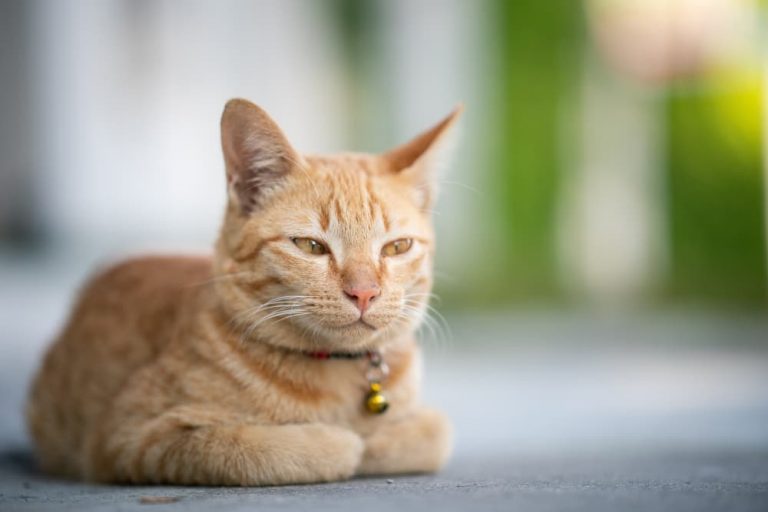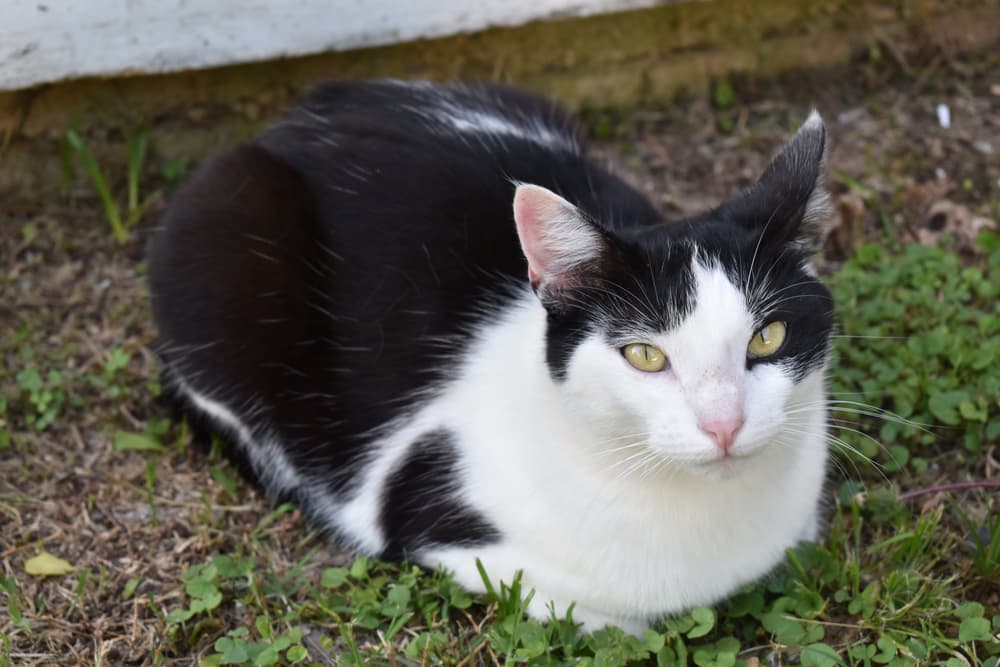Cat Loafing: What It Is and Why They Do It

Cats are pretty darn cute no matter what they’re doing. As annoyed as we may get when they try to knock a water glass off the edge of a table, we still find our kitties irresistibly adorable. Some may argue that no feline pose is as precious as cat loafing – a position so charming that it inspired an Internet meme.
But why do cats assume this body posture, and is it ever something to cause a pet parent concern? Let’s dive in.
Cat Loafing: What Does It Look Like?
When a cat sits with all four paws tucked underneath itself and its tail also tucked or wrapped around its body, it resembles a compact rectangle with rounded edges, much like a loaf of fresh bread. The resemblance is even more pronounced when a cat assumes this position in a too small box with its top spilling over the sides like risen dough. Thus, the term “cat loaf” was born.
The term “cat loaf” (or “catloaf”) has been used widely since 1999, when it first appeared in Usenet news groups. It then morphed into a meme that rose in popularity in the 2010s on Reddit, Twitter, and Facebook. Similar terms include “bread cat,” “potato cat,” or “tugboat cat.”
Cats really have become Internet rock stars, and an entire website (kittyloaf.com) is devoted to curating images of cats in this adorable loaf-like posture. Curious what a cat in the loafing position looks like from underneath? A quick search for “hover cat” on a glass table will be sure to give you a nice hit of serotonin for the day.
Types of Cat Loafs

A cat is usually relaxed while loafing, but they tend to use this position while observing their surroundings. A cat’s head will be upright, and its eyes will often be fully open or half-closed. While we can all recognize the classic loafing position, several variations exist. A cat or kitten of any age can assume these various positions.
When a cat is in a full loaf, all its feet are tucked underneath itself, and its tail is either also tucked or wrapped tightly around its body.
A cat’s elbows may be slightly out in the partial loaf. The front paws may either be tucked or flat on the ground.
When one elbow is extended more than the other, a cat is in a loaf boat position.
A cat may also be sitting flat on its abdomen and resting on its back haunches with one or both of its front limbs slightly extended, assuming the Sphinx pose as named after the ancient Egyptian monument it resembles.
If a cat is especially sleepy, its head may start to dip downwards, causing it to face loaf. However, the face loaf posture can also be an indication that your cat is ill.
Why Do Cats Loaf?
The way a cat tucks in its extremities while lying on its abdomen carries a different meaning than when it’s merely sitting upright, lounging with its limbs and tail out, curled in a ball on its side, or about to pounce. So what exactly does a cat loaf mean?
Your cat is relaxed. Cats assume this compact, cozy position for comfort and relaxation when they still wish to engage with their surroundings but are not planning to jump or run away. Loafing cats exhibit trust and submission, but this posture still allows them more security and protection than lying on their back or side and exposing their belly.
Your cat doesn’t feel threatened. Pet parents are paid a compliment when a cat loafs in their presence: your cat does not feel threatened and therefore does not feel the need to be on the defense. Loafing cats may be a bit drowsy but are not tired enough to sleep fully – they want to observe and be entertained by the happenings in their environments. They often simply enjoy the company of their humans while they sit in a loaf.
Your cat is trying to retain heat. Furthermore, cats have also learned evolutionarily that they can retain heat without having to move and expend precious energy while they assume the loaf position. Energy can thus be stored for periods of activity when cats need it. This tactic is especially important to kittens and short-haired breeds who can easily lose heat. Cats can regulate their temperature better in this compact, self-huddled position.
Your cat is getting comfortable. Since the loaf posture helps take pressure off a cat’s legs and paws, it may be assumed merely for comfort, much like us humans taking our shoes off and elevating our feet after a long day.
Your cat might be in pain. While a cat loaf position is usually associated with positive feelings of relaxation and comfort, it could indicate pain in certain scenarios. If a cat is spending the majority of its time in a loaf, this is a red flag. If a cat is consistently sitting hunched with its paws flat on the ground or perched up on its toes, foot or limb pain may be the culprit.
Is Cat Loafing Ever a Problem?

Cat loafing is a normal behavior in the majority of cats, especially if your kitty assumes this posture on a comfortable and warm spot such as on the carpet where a ray of sun is beaming in through the window or on a cozy pile of laundry fresh from the dryer.
However, if your cat is repeatedly found randomly loafing in the middle of the floor or on a cold, uncomfortable surface, it’s time to investigate further. If your cat is experiencing other worrisome signs such as hiding, decreased appetite, litter box issues, lethargy or weakness, abnormal gait (such as limping), vocalizing in pain, or difficulty breathing, it’s time to call your veterinarian and have your pet examined for potential illness or injury.
So long as your cat is still active at other times during the day, he or she can enjoy cat loafing without pet parents worrying their cat is not getting enough exercise or is losing mobility. However, if a cat primarily spends its day in a loaf position without moving or being active, your cat may be experiencing foot or leg pain.
Cats are experts at masking pain. If your cat is constantly loafing, they may be trying to protect a front paw injury or hide signs of pain from an ingrown nail. Signs of pain in cats include guarding its paws or else not being able to fully tuck them in (which may indicate osteoarthritis), lowering its head, keeping its eyes shut or displaying exposed third eyelids, licking its paws, limping, or the other signs mentioned above.
Additionally, cats with heart or lung diseases may sit hunched with their elbows extended outward and their heads lowered to make breathing easier. Cats with abdominal pain, such as liver disease or chronic kidney disease (CKD) may also sit in the loaf position in order to help take pressure off internal organs.
Cats with CKD may not feel their best, therefore spending more time in a comfy loafing position. CKD is a relatively common medical condition in geriatric felines. Between 30-50 percent of cats over 15 years of age are estimated to have CKD. Early detection via regular bloodwork and urinalysis is key to initiating prompt care. Though CKD cannot be cured, certain therapies can slow its progression and improve the quality of life of affected cats while increasing longevity. Eating a prescription veterinary renal diet, regulating high blood pressure, and maintaining hydration can help improve the quality of life of cats with CKD.
Most loafing cats will hold their heads upright. However, if your cat is holding its head down and face planting, this can be an indication of illness. For example, cats with hypokalemia (low blood potassium), may experience cervical ventroflexion, or weakness when trying to lift the head. Causes range from chronic kidney disease to low blood sugar (hypoglycemia).
If your cat is experiencing any of the issues described above, or if you’re ever in doubt that your cat’s behavior is abnormal, schedule an appointment with your veterinarian.
The Conclusion on Cat Loafing
While some cats in the loaf position may have underlying medical issues that need to be addressed with your veterinarian, the majority of the time, pet parents can rest assured that the cat loaf posture is generally normal and indicates trust and contentment in the presence of the pet guardian.
So the next time you slather a layer of butter onto the slice of warm homemade bread fresh out of the oven, you can smile – not only at the carb-y goodness in front of you, but also at the reminder that your loafing kitty is the cutest pet in the world.









